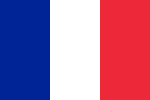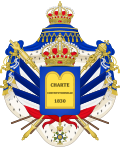July Monarchy
|
Royaume de France Kingdom of France 1830–1848 |
|||||
|
|||||
| Motto : unknown | |||||
| Constitution | Constitution of the Kingdom of France | ||||
| Official language | French | ||||
| Capital | Paris | ||||
| Form of government | kingdom | ||||
| Form of government | Constitutional monarchy | ||||
| Head of state | King of the French Louis-Philippe I. | ||||
| Head of government |
Prime Minister Achille-Léon-Victor de Broglie (1830 and 1835–1836) Jacques Laffitte (1830–1831) Casimir Pierre Périer (1831–1832) Nicolas Jean-de-Dieu Soult (1832–1834, 1839–1840 and 1840–1847) Étienne-Maurice Gérard (1834) Hugues-Bernard Maret (1834) Édouard Adolphe Mortier (1834–1835) Adolphe Thiers (1836 and 1840) Louis-Mathieu Molé (1836–1839 and 1848) François Guizot (1847–1848) |
||||
| currency | French Franc | ||||
| Beginning | 1830 (July Revolution) | ||||
| The End | 1848 (February Revolution) | ||||
| National anthem | La Parisienne | ||||
| map | |||||
|
|
|||||
The July monarchy began in France in 1830 after the July Revolution when King Louis-Philippe I. His predecessor, Charles X , had abdicated as a result of the revolution.
history
The July Revolution of 1830 ( Les Trois Glorieuses ) resulted in the final overthrow of the Bourbons in France and the renewed seizure of power by the bourgeoisie in a liberal kingdom. The cause of the revolution was the reactionary policies of King Charles X. When the king tried to dissolve parliament, craftsmen, workers and students rose up in Paris in July 1830 and forced the king to abdicate and flee to England. Louis Philippe, who came from a Bourbon branch line Orléans , was called the citizen king because of his relatively liberal attitude . His reign was, at least initially, supported by the upper class. In terms of its political structure, the July monarchy can be described as a kind of hybrid of a constitutional and a parliamentary monarchy. The Chamber of Deputies and the Chamber of Peers from the Restoration period were considerably expanded in their powers, but the king retained significant influence on government and foreign policy. The French bourgeoisie , however, was visibly disappointed in the king's policy . Above all, the census suffrage , which prevented the bourgeoisie from having an influence on legislation commensurate with its strength, increased dissatisfaction. An agricultural and trade crisis in 1847 led to unrest and ultimately to the February bourgeois revolution of 1848. The July monarchy ended with the establishment of the Second French Republic .
literature
- HAC Collingham, RS Alexander: The July monarchy: a political history of France, 1830 - 1848 . London: Longman, 1988 ISBN 0-582-01334-8


